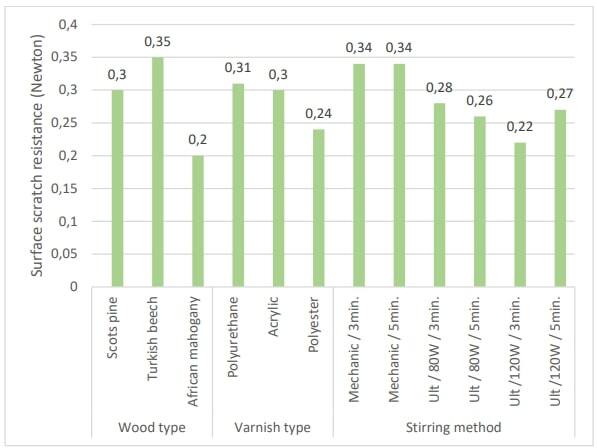Archive
Online first
Current issue
Instructions for Authors
Guide for authors
Peer Review Policy
Research Ethics Policy
Crossmark Policy
Ghostwriting and Guest Authorship
Copyright
Open Access Policy
Plagiarism
About the Journal
Aim and Scope
Scientific Board
Publisher
Editorial Board
Indexing in databases
Personal Data Protection
Repository policy
Contact
ORIGINAL PAPER
The Impact Of Ultrasound-Assisted Mixing Method For Varnish And Components On The Varnish Layer’s Surface Hardness And Surface Scratch Resistance
1
Woodworking Industrial Engineering, Mugla Sitki Kocman University, Turkey
Submission date: 2023-10-11
Final revision date: 2024-07-31
Acceptance date: 2024-08-13
Online publication date: 2024-08-28
Publication date: 2024-08-28
Corresponding author
Drewno 2024;67(213)
KEYWORDS
TOPICS
ABSTRACT
The objective of this study was to determine effects of mechanical and ultrasound-assisted stirring methods for varnish + components mixing on the varnish layer’s surface hardness and surface scratch resistance. The study focused on polyurethane, acrylic, and polyester varnish systems, which were applied to three distinct wood types: Scots pine (Pinus sylvestris L.), Turkish beech (Fagus orientalis Lipsky), and African mahogany (Khaya ivorensis A. Chev.). The mixing processes included mechanical stirring for 3 and 5 minutes, as well as ultrasound-assisted stirring with varying power levels (80 watts and 120 watts) for 3 and 5 minutes. The results indicated that the highest surface hardness was achieved using the mechanical stirring method for Turkish beech with polyester varnish at 3 minutes of stirring (175.10), while the lowest surface hardness was observed for African mahogany with acrylic varnish and 120 watts ultrasound-assisted stirring for 5 minutes (66.80). The highest surface scratch resistance was observed in Scots pine treated with polyester varnish using mechanical stirring for 5 minutes (0.760 N), and in Turkish beech treated with acrylic varnish using 80 watts ultrasound-assisted stirring for 3 minutes (0.760 N). Overall, the findings suggested that the ultrasound-assisted mixing method generally fell short in terms of enhancing the varnish properties compared to the mechanical mixing technique.
REFERENCES (18)
1.
Baykan, İ., Kılıç, Y., ve Bakır, K. (2000). “Mobilya Endüstrisinde Üs tyüzey İşlemleri”, KOSGEB Küçük Ölçekli Sanayi Geliştirme ve Destekleme İdaresi Başkanlığı, Ankara, (In Turkish).
2.
Cheng Y, Wang Q. (2022). Enhancement of Green Tires Performance through Ultrasound-Assisted Mixing. Polymers. 14(3):418.
3.
Effendi A, J., Marita W. (2019). "The impact of ultrasonic power and time for the removal of Total Petroleum Hydrocarbon from low permeability contaminated soils". The 1st International Conference on Environmental Sciences (ICES2018). Earth and Environmental Science 314.
4.
Gungoren, C., Ozdemir, O., Wang, X., Ozkan, S. G., & Miller, J. D. (2019). Effect of ultrasound on bubble-particle interaction in quartz-amine flotation system. Ultrasonics sonochemistry, 52, 446-454.
5.
Gurleyen, L. (2021). Effects of Artificial Weathering on the Color, Gloss, Adhesion, and Pendulum Hardness of UV System Parquet Varnish Applied to Doussie (Afzelia africana) Wood. BioResources 16(1), 1616-1627.
6.
He, T., Y. He, H. Li, Y. Fan, Q. Yang, Z. He. (2018). A comparative study of the effect of mechanical and ultrasound agitation on the properties of pulse electrodeposited Ni-W/MWCNTs composite coatings. Journal of Alloys and Compounds 743, 63-72.
8.
Masri, A.N., M.I. Abdul Mutalib, Noor Fathanah Aminuddin, Jean–Marc Lévêque. (2018). Novel SO3H-functionalized dicationic ionic liquids – A comparative study for esterification reaction by ultrasound cavitation and mechanical stirring for biodiesel production. Separation and Purification Technology 196:106–114.
9.
Nejad Mojgan, Paul Cooper, Veronic Landry, Pierre Blanchet, Ahmed Koubaae. (2015). ‘Studying dispersion quality of nanoparticles into a bio-based coating’ Progress in Organic Coatings Volume 89, December, 246-251.
10.
Shi, J.L.; Kocaefe, D.; Zhang, J. (2007). Mechanical behavior of Quebec wood species heat-treated using Thermowood process. Holz Als Roh-Werkst 65:255-259.
11.
Vardanyan Vahe, Bouddah Poaty, Gre´gory Chauve, Ve´ronic Landry, Tigran Galstian, Bernard Riedl. (2014). Mechanical properties of UV-waterborne varnishes reinforced by cellulose nanocrystals. J. Coat. Technol. Res., 11 (6) 841–852.
13.
Zanghellini, B.; Knaack, P.; Schörpf, S.; Semlitsch, K.-H.; Lichtenegger, H.C.; Praher, B.; Omastova, M.; Rennhofer, H. (2021). Solvent-Free Ultrasonic Dispersion of Nanofillers in Epoxy Matrix. Polymers 2021, 13, 308.
14.
Çakıcıer, N., Korkut, S., & Korkut, D. S. (2011). Varnish layer hardness, scratch resistance, and glossiness of various wood species as affected by heat treatment. BioResources, 6(2), 1648-1658.
15.
Mason, T. J., Riera, E., Vercet, A., & Lopez-Buesa, P. (2005). Application of ultrasound. In Emerging technologies for food processing (pp. 323-351). Academic Press.
16.
Povey, M., & Mason, T. (1998). Ultrasound in Food Processing. Technology & Engineering Springer, p:282.
17.
Megep 2012: Furniture and Interior Design. Top coat varnish. Republic of Turkey Ministry of National Education, Ankara (In Turkish).
18.
Şanıvar, N., & Zorlu, İ. (1980). Ağaç işleri gereç bilgisi temel ders kitabı. Mesleki Ve Teknik Öğretim Kitapları, Milli Eğitim Basımevi, İstanbul, Etüd ve Programlama Dairesi Yayınları, (43), 472. (In Turkish).
Share
RELATED ARTICLE
We process personal data collected when visiting the website. The function of obtaining information about users and their behavior is carried out by voluntarily entered information in forms and saving cookies in end devices. Data, including cookies, are used to provide services, improve the user experience and to analyze the traffic in accordance with the Privacy policy. Data are also collected and processed by Google Analytics tool (more).
You can change cookies settings in your browser. Restricted use of cookies in the browser configuration may affect some functionalities of the website.
You can change cookies settings in your browser. Restricted use of cookies in the browser configuration may affect some functionalities of the website.



